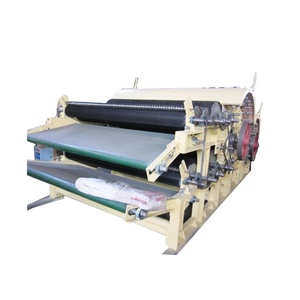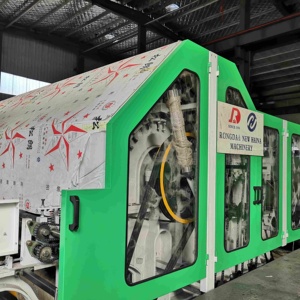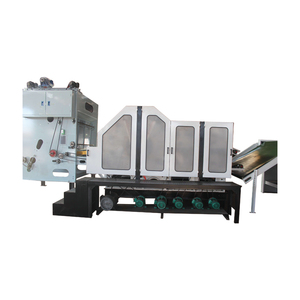
All categories
Featured selections
Trade Assurance
Buyer Central
Help Center
Get the app
Become a supplier

(6047 products available)














Market Overview: The global textile machinery market, which encompasses wool carding machines, reached a valuation of approximately US$ 29.6 billion in 2023, and is projected to grow to US$ 48.9 billion by 2032, reflecting a compound annual growth rate (CAGR) of 5.74% from 2023 to 2032, according to Research and Markets. This growth is largely driven by the rising demand in the apparel industry and the increasing adoption of automated textile machinery that enhances product uniformity and efficiency. The expanding fast-fashion trend is particularly stimulating the need for innovative textile solutions, including wool carding machines, as manufacturers seek to produce contemporary clothing that meets evolving consumer preferences for quality and style.
Industry Insights: The market for wool carding machines is also influenced by significant shifts in consumer behavior, with a growing emphasis on sustainability and textile recycling. As environmental concerns become more prevalent, manufacturers are integrating eco-friendly practices into their operations, which includes the use of wool carding machines that facilitate the recycling of textiles. Furthermore, the competitive landscape features key players focused on innovation, with many developing automated solutions to streamline production processes. The Asia-Pacific region is expected to lead market growth, driven by robust textile manufacturing bases in countries like China and India, where urbanization and rising disposable incomes are propelling demand for high-quality textiles, including woolen products.
A wool carding machine is a textile device used to comb wool into long strands or webs suitable for spinning into yarn. These machines are used in the woolen industry and by handspinner communities to prepare wool fiber. Wool carding machines have evolved over time, and now there are various types of carders used to process wool.
Drum carder
A drum carder is a larger version of a hand carder and consists of two cylinders covered in fine wire bristles. The smaller motorized drum is turned by hand, while the bigger belt-driven drum is rotated by a driving belt connected to the motor. Wool is placed on the conveyor of the smaller drum, and as it turns, it is brushed out in a fluffy batt on the bigger drum. Once the wool has been processed, it is removed by a cleaning comb.
Disk carder
Also known as a circle carding machine, it uses two disks covered in fine wire bristles to untangle fiber. The first disk untangles the fibers, and the second one collects the newly organized fiber as a fly. The new fiber can then be processed further into woolen yarns.
This carder uses a flat surface prepared with bristles in a path-like manner. The wool is spread along the path and brushed out into a fluffy batt further along the path. Flat carders are typically used in more extensive carding setups where larger quantities of wool need to be processed quickly and efficiently.
Roller carder
It is perhaps the most complex design and functionality wise. This carding machine has several rollers and belts that brush out the wool and untangle it across varying sizes of flat pieces that act as brushes. Once the fiber is processed, it is collected in bins and can be further processed into woolen yarns.
Floor carder
This large and complex carding machine has a belt driving a large roller that untangles wool on flat surfaces. It is used in large-scale wool processing facilities where large quantities of wool need to be processed into final products such as woolen yarns and wool batting.
Industrial carding machine
These large-scale carding machines are typically used in commercial textile facilities where large quantities of wool or wool-like fiber need to be processed into woolen yarns or wool batting further into finished textile products. They usually feature advanced automation and computer control to streamline the carding process efficiently and accurately.
Wool carding machines' specifications vary depending on whether they are rotary or oscillating. Their capacity also varies depending on the type and wool carding machine involved. The capacity may range from about 30kg to 3000kg (raw material) per hour. Additionally, speed varies with the type of machine. The final processed wool will be approximately 3 to 5 times heavier than the wool fiber material.
The horsepower of wool carding machines ranges between one and three depending upon the machine's size and capacity. Larger unit horsepower may range from 5hp to 10hp or even higher.
The width of the drum of wool carding machines varies depending upon the machine involved and their function. Smaller drum widths start from 800mm and larger drums may have a drum width of about 1,400mm or more. The overall dimensions of a wool carding machine also varies with the type of the machine. The floor space occupied by smaller machines may be about 1,600mm in length and 1,200mm in width. Larger machines may occupy a floor space of about 6,000mm in length and 3,500mm in width.
It is essential to note that the dimensions, weight, and capacities of a wool carding machine will differ depending upon whether it is a woolen carding machine or an cotton carding machine. Other attributes will also differ depending upon whether the machine is an industrial-scale heavy-duty machine or a small domestic-scale carding machine.
Maintenance requirements of a wool carding machine:
The primary purpose of wool carding machines is to detangle and fluff up wool and other animal fibers, making them ready for spinning into yarn. These machines have evolved remarkably over the years, revolutionizing the wool carding process.
Carding machines are popular in the following settings:
Commercial Wool Processing Plants
Processing plants use industrial-scale carding machines to handle large quantities of raw wool. The machines fluff the wool and prepare it for spinning into yarn. Commercial carding machines have a higher capacity and are more efficient than smaller machines to meet the demands of commercial production.
Textile Factories
Some factories use wool carding machines to process wool and other animal fibers, such as alpaca, cashmere, and mohair. The carded fiber is then transformed into yarn for making woolen fabrics. These are used to produce garments, blankets, and other textile products.
Small-Scale Fiber Processing Facilities
Wool carding machines are used at small-scale fiber processing facilities to offer carding services to local farmers and fiber producers. The carded wool from these facilities is often spun into yarn on-site or sent to external spinning mills.
Hand Spinning Workshops
Some workshops use carding machines to produce carded wool for hand spinners. Smaller carding machines are more affordable for hand spinning enthusiasts and are often used in combination with hand-held tools.
Educational Institutions
Wool carding machines can be found in trade schools, agricultural colleges, and other educational institutions that offer courses in fiber processing, textile technology, or sheep husbandry. These schools may use the machines for instructional purposes to teach students about the carding process, wool quality, and yarn production.
Art and Craft Studios
Small carding machines are used in art and craft studios to produce unique carded wool products for creative projects, such as felting, mixed media, or textile art. These are more creative and artistic carding methods that may involve dyeing and blending different fibers.
Determine the amount of wool to be processed:
Investigate how much wool the business will process. This will be a major factor in deciding the size and capacity of the carding machine. Small-scale operations will work fine with a portable carder whereas large-scale carders suit commercial premises better.
Decide whether to use an electric or hand carding machine:
An electric wool carding machine is more efficient than a hand-powered version but it may be more cost-prohibitive. A hand carding machine requires the operator to pedal the machine manually and it may also be limited to processing smaller batches of wool.
Check the quality of the wool fluff:
When wool is carded, it is fluffed out into a mat. Different machines will produce varying levels of wool fluff. Some prefer the more refined carded wool while others don’t mind the lesser quality.
Consider the investment:
Purchasing an industrial-scale carding machine is a sizable investment. Consider the machine's multi-functionality such as its ability to wash, dry, scour, de-oil, card, open, and separate wool fibers. It could help offset the cost of production in future.
Think about future business expansion:
Choose a wool carding machine that can meet future business demands if the company plans to expand its wool-processing activities in a few years' time.
Assess the need for additional processing machinery:
An advance wool carding device may be able to perform other functions such as spinning, weaving, and knitting. This could eliminate the need to buy additional separate processing machines.
Q1: Can computers control the wool carding machine?
A1: Yes. Modern carding machines use a computer system to control the carder's speed, feed rate, and other parameters. This will enhance the efficiency of the machine and improve the consistent quality of the processed wool.
Q2: What are the trends in the wool carding machine industry?
A2: The carding machine market is always developing. The trend now is toward automation and eco-friendliness. More and more machines will use automated self-contained units to meet different industries' needs. Carding machines will have energy-saving programs to reduce the consumption of electricity and save the environment.
Q3: Can people still use hand wool carders?
A3: Yes. Hand wool carders are still used by some small-scale artisans and crafters who wish to have more control over the wool processing. They may use the hand carder to prepare the wool for spinning or to achieve a particular texture or quality in the wool preparation.
Q4: Do carding machines damage wool fibers?
A4: No. A properly functioning and well-maintained carding machine will not damage wool fibers. The main purpose of the machine is to separate, untangle, and blend the fibers. If the machine is not maintained well, it could tear the fibers. This is one of the reasons why routine maintenance is essential.